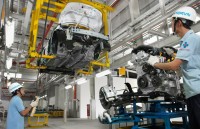
Vietnam can gain from the US-China trade war: Economist
Latest
| TIN LIÊN QUAN | |
| RoK footwear firms to increase investment in Vietnam | |
| 20 items earn more than 1 billion USD in export revenue in H1 | |
For Professor Pham Tat Thang, senior researcher at the Trade Research Institute at the Ministry of Industry and Trade, it seems as though no one will win in the US-China trade war, neither the two nations involved nor the world’s economy.
 |
| Seafood processing for export. (Illustrative photo: VNA) |
First of all, this war is threatening the global economy as it goes against the global trend towards trade liberalisation and triggers the rise of protectionism. It could result in a global economic slowdown and impact Vietnam’s economy in a bad way, Thang explained.
Chinese products and projects will not be allowed to make their way into the US like before so Chinese government and enterprises are likely to find alternatives for them in neighbouring markets like Vietnam, he noted.
Once Chinese exports scale down, reducing its liquidity, demand for imports in China will also decline. This, together with China’s escalation of trade barriers, could hurt Vietnam’s exports to the neighbouring country, which have experienced upturn in recent years, according to the researcher.
However, Chinese products hit by high tariffs will lose their competitive edge in the US, opening the doors for similar goods from Vietnam. Hence, if Vietnam can make the most of the situation, it could turn challenges into opportunities.
On the other hand, Thang warned that Chinese exporters are likely to try to find a way around to disguise their origin of goods to avoid the US tariffs. They could fake that their products are originating in Vietnam, he said.
“If we don’t stay on watch and this happens, it will harm the Vietnam-US trade relations as well as national interests in the long run,” he added.
The economist urged Vietnamese enterprises to be aware of technical trade barriers in each foreign market as well as to stay up to date in related regulations in order to survive the turmoil of protectionism in the global trade.
As foreign countries are raising trade barriers, domestic firms must be updated on the changes to be able to satisfy new requirements, he suggested. They should also cooperate with each other to protect themselves and prevent violations occuring, he noted.
The trade war between the US and China officially commenced on July 6 after the US pulled the trigger on 25 percent duties on approximately 34 billion USD worth of Chinese machinery, electronics, and high-tech equipment imports.
This is only Washington’s first step in a trade confrontation that is likely to hurt not only the economies of the US and China, but also threaten global economic instability. Vietnam is also set to become embroiled in the conflict as both the US and China are important trade partners for the country.
Last year, China was the largest trade partner of Vietnam. The bilateral trade between the two sides was estimated at 93.8 billion USD, of which exports to China reached 35.3 billion USD, up 60.6 percent year-on-year, and imports from China totalled 58.5 billion USD, up 16.9 percent year-on-year.
Vietnam’s trade deficit with China was 23.3 billion USD, down 17.4 percent.
The US ranked third in bilateral trade with Vietnam with 50.7 billion USD, of which export values hit the highest level of 41.5 billion USD, a year-on-year increase of 8 percent, and import values stood at 9.1 billion USD, up 4.9 percent.
 | BNI Vietnam National Conference draws over 1,000 entrepreneurs The Business Network International (BNI) Vietnam National Conference opened in the northern port city of Hai Phong on July 12, drawing more than 1,000 entrepreneurs. |
 | Foreign exchange rates likely to rise amidst US-China trade war Foreign exchange rates are likely to rise strongly due to concerns that the US-China trade war may be escalating, said Director of the Vietnam Institute ... |
 | Japanese firms boost investment in precision mechanics Japanese businesses have been working with Vietnamese partners in technology transfer and equipment manufacturing, as well as increasing investments in precision mechanics. |

























